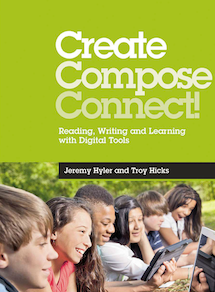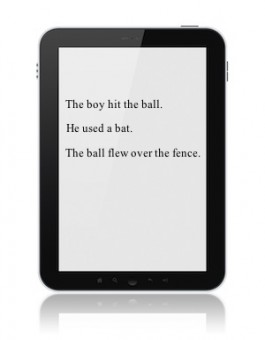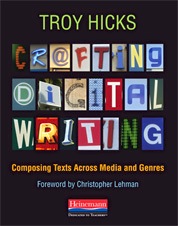Lesson Idea: Using Technology to Teach Sentence Combining

As we gear up for another school year, many of us are fortunate to have new technologies in our classrooms. Laptops. Tablets. Interactive whiteboards. Shiny, new, and, well, sometimes a bit difficult to figure out how to use in productive, creative ways.
In my many conversations with teachers about when, how, and why to use technology for teaching purposes, one of my foremost questions has been: What can this <choose one: website, app, device, system> do for you and/or your students that pencils, paper, and imagination simply could not do alone?
Put another way, how can the technology be used to further your goals for student learning by working with content in new ways?

This lesson idea describes a process for furthering our goals related to working with words by helping students make their writing process visible with the use of technology.
Understanding sentence combining
While Language Arts teachers have long known that teaching grammar and isolation is both boring and highly ineffective, we are often not presented with ideas for teaching those skills in a productive or creative manner.
Educators such as Jeff Anderson have been advocates for focusing on the small moves that writers make through revision and editing, while Douglas Fisher and Nancy Frey have described how using sentence frames can help move students forward with their writing by structuring thinking.

As a skill that “encourages a writer to take two or more short, choppy sentences and combine them into one effective sentence,” sentence combining is not just an exercise like “daily oral language” where students try to correct errors in an existing sentence.
Instead, students are actively working as writers, manipulating grammatical structures and thinking carefully about how words convey meaning depending on where they are located in a sentence.
Even though we could dismiss this strategy because we are not making students memorize the difference between a dangling modifier and a participial phrase, I don’t think this is the case. We do not have to hold students accountable for each and every grammatical term so long as they can use grammar effectively to improve the quality of their writing.
Many resources exist for thinking about how to teach sentence combining, yet none that I have seen have taken an active approach to integrating technology, and here is where we have a chance to innovate with all the new tools in our classrooms. When we ask our students to make the writing process visible through the use of technology, my hope is that they will become more adept at understanding why certain choices help them as writers.
Teaching sentence combining with tech tools
As I consider the ways that I might use technology to teach sentence combining, I again return to the question asked above: what can technology do that pencils and paper simply could not do alone? My answer to that question here is that technology can allow us to record and reflect on the writing process in ways that pencil and paper could not. I demonstrate this in the screencast below, recorded with Camtasia.
Other ideas about teaching grammar with technology
Now that you have viewed the ways that I might teach sentence combining with a word processor and screencasting, think of the way that this lesson could be adapted for various technologies and extended in many ways throughout the school year.
Using an interactive whiteboard, for instance, you might underline or circle different parts of speech using different color styluses, then show where those words end up in the revised sentences. Using an iPad, you could have students record their screencasts using Explain Everything or, on a computer, using Screenr. The technologies available continue to expand, yes, but the core of the lesson remains the same: invite students to use sentence combining to craft a variety of examples, playing with language in a way that can help them grow as writers.
More importantly, consider this: I could not have taught a lesson on sentence combining – or asked students to reflect on their own writing – without having used technology in this manner. This is a case where the technology is both useful and necessary. Paper, pencils, and even an overhead projector would not allow us to capture students’ writing processes in this manner. Word processors and screencasting can.
How else might you adapt your lessons to integrate existing technologies? Share your ideas here. There are certainly many more opportunities that you and your students will figure out, and I encourage you to move beyond using new technologies as simply a replacement for pens and paper, instead capturing their full capabilities as digital writing tools.





































Thanks, Troy. This is great. Two small ideas that might be transformative: 1) Have you checked out the “Draftback” app for GDocs? 2) Also, imagine the subtle work with breaking gender stereotypes you could do simply by changing the agent of power (“the boy”) to “the girl.” Thanks for sharing the lesson.